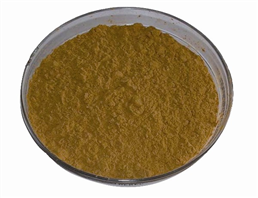

Ferrous Bisglycinate 20150-34-9
| Price | USD16.00 |
| Packge | 1KG |
- Min. Order:1KG
- Supply Ability:10tons
- Time:2022-06-06
Product Details
- Product NameFerrous Bisglycinate
- EINECS No.606-444-7
- MFC4H8FeN2O4
- MW203.96
- AppearanceSolidPale Brown to Brown
- storage temp. Keep in dark place,Inert atmosphere,Room temperature
- Melting point >162°C (dec.)
- density 1.898 at 20℃
- Boiling point 150℃ at 101kPa
- Water Solubility Water: 35.71 mg/mL (176.83 mM)
| Uses | Ferrous Bisglycinate is an iron-amio acid chelate. In this the iron is protected from the action of absorption inhibitors by being bound to the amino acid and glycine. Ferrous bisglycinate is the major amino acid chelate produced commercially, although ferrous trisglycinate and ferric glycinate are also available. A patented ferrous bisglycinate compound, manufactured by Albion Laboratories, Utah, USA, has been used in most published studies. The chelate is reported to be formed by two glycine molecules combining with ferrous iron in a double heterocyclic ring structure. Evidence would suggest that iron is protected from inhibitors by the structure, since iron absorption is one to 3.5 times higher than from ferrous sulfate when added to bread rolls and milk products containing inhibitors such as phytate and calcium. Ferrous bisglycinate is more bioavailable than ferrous trisglycinate. |
| Food additive | Amino acid chelates are recommended for milk and beverage products. Ferrous bisglycinate has Generally Recognized as Safe (GRAS) status but is relatively expensive and readily promotes fat oxidation in cereal foods unless an anti-oxidant is added, and causes undesirable color reactions in some foods. Four non controlled efficacy studies with ferrous bisglycinate fortified foods have reported a marked decrease in the prevalence of anemia or iron deficiency anemia in children or adolescents. Three studies made in Brazil reported good efficacy in fortified liquid milk, sweetened bread rolls and a whey based beverage, and a fourth study in Saudi Arabia reported good efficacy in an iron fortified flavored milk drink. Recently, fer- rous bisglycinate fortified bread made from high extraction flour resulted in small but significant increases in both hemoglobin and serum ferritin when fed in a randomized controlled design to South African schoolchildren. A longer feeding period with higher iron concentrations would probably have given more impressive results. The influence of ferrous bisglycinate on stored flour was not investigated in this study. The main disadvantage of ferrous bisglycinate is its high cost. A recent cost analysis showed the cost of ferrous bisglycinate, taking bioavailability into account, to be 7–18 times that of ferrous sulfate. |
| Food additive | Ferrous bisglycinate is well suited to the fortification of liquid whole milk and other dairy products where the use of ferrous sulfate causes rancidity off-flavours. However, ferrous bisglycinate can also cause rancidity by oxidizing fats in food, which can be a problem in cereal flours and weaning cereals unless an antioxidant is added as well. Furthermore, the bisglycinate is much more expensive than many other iron compounds. |
Company Profile Introduction
Baoji Guokang Health Chemical Technology Co., Ltd has a subsidiary, Baoji Guokang Bio-Technology Co., Ltd. It is located in Baoji High-tech Zone,with epitomizing international, cooperative and honest. We are a young company full of action and energy, our profession improves us rapid progress, which satisfy our clients both in home and abroad. We are specialized in API's intermediates, fine chemicals and plant extracts.We toughly insist on that quality is always the most important item not only for us, but also for our clients. It is believed that we could be considered as the most powerful man in the area of chemicals with combined strength in R&D and Marketing. We are a "customer first" company and believe that our success depends on double-wins.our customers are from more than 160 countries worldwide ,we work closely with every customer to support high quality business service. Our target purpose is "provide favorable value,convenient and flexible solutions for you."we promise: reasonable prices, short supplying period and satisfactory after-sales service. Buyers are welcome to contact us !
Recommended supplier
-
VIP1年
- ARRAKIS INDUSTRIES LLP
- FERROUS BIS-GLYCINATE 99%
- Inquiry
- 2024-11-05
-
VIP1年
- Aditya Chemicals
- Ferrous bisglycinate 20150-34-9 98%
- Inquiry
- 2024-01-31
-
VIP1年
- Global Calcium Pvt Ltd
- Ferrous bisglycinate 99%
- Inquiry
- 2024-01-27
-
VIP1年
- Rivashaa Agrotech Biopharma Pvt. Ltd.
- 20150-34-9 98%
- Inquiry
- 2024-01-25
-
VIP1年
- West Bengal Chemical Industries Ltd.
- 20150-34-9 Ferrous bisglycinate 98%
- Inquiry
- 2024-01-23
-
VIP1年
- ShanPar Industries Pvt Ltd
- Ferrous bisglycinate 20150-34-9 99%
- Inquiry
- 2024-01-17
-
VIP1年
- HRV Global Life Sciences
- Ferrous bisglycinate 99%
- Inquiry
- 2024-01-12
-
VIP1年
- SAANVI CORP
- Ferrous Bis Glycinate 99%
- Inquiry
- 2023-12-27
- Since:2018-09-06
- Address: Room B801, Financial Plaza, Jintai District, Baoji, Shaanxi, CN
